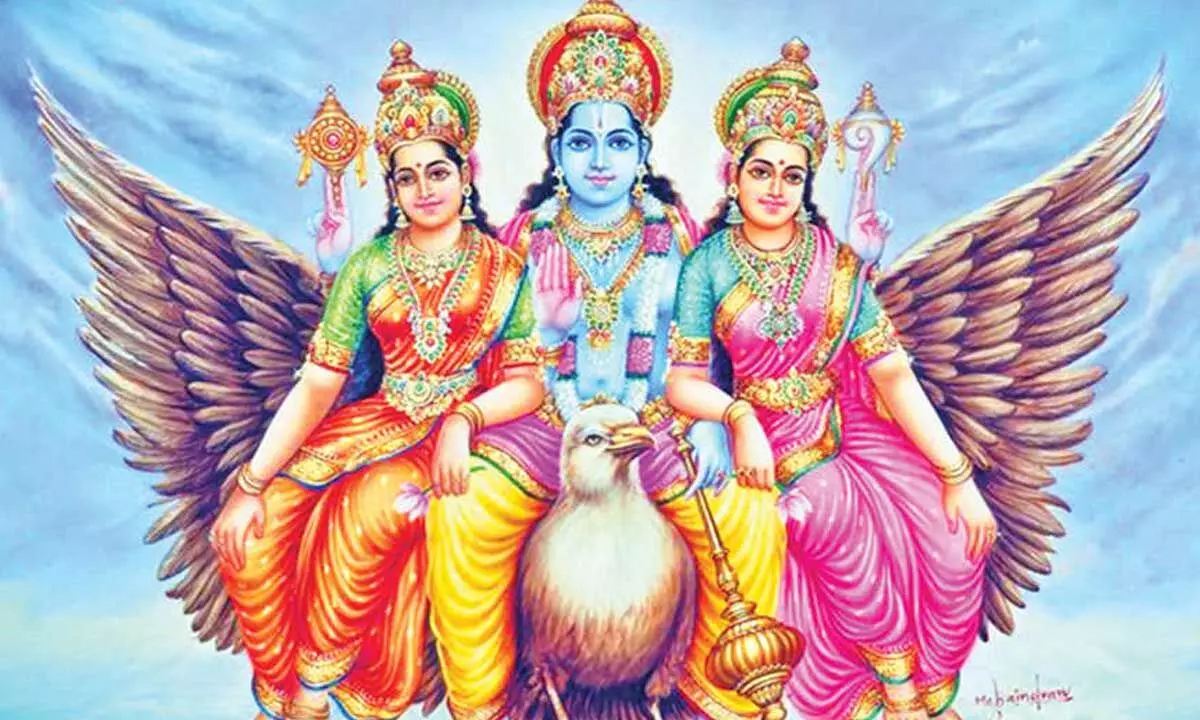Live
- Omar Abdullah Urges Congress To Earn INDIA Bloc Leadership Role
- Yogi Adityanath Contrasts Historical And Modern Treatment Of Workers In India
- Historic Temple In Sambhal Reopens After 46-Year Closure Following 1978 Riots
- Officials directed to work for deeper reach of guarantees
- Delay In 'One Nation, One Election' Bills Introduction Announced
- Exhilarating ‘Benchmark’ of Venkat Changavalli
- Development activities worth `30 cr launched in Puthalapattu constituency
- Allegations against KTR baseless: BRS leader
- Megastar Chiranjeevi to Visit Allu Arjun’s Residence at 12 PM Today
- Nilima Rane: Trailblazer in Nursing
Just In

Dharma is an abstract noun, as we know, but by using the versatile tool of allegory, writers build connections with several other abstract nouns and create relationships.
Dharma is an abstract noun, as we know, but by using the versatile tool of allegory, writers build connections with several other abstract nouns and create relationships. It is close to symbolism. When we say that Vishnu has two wives – Lakshmi and Bhudevi (goddess Earth), it does not mean that he is a person with a family, with a two-bedroom house and is living with them.
Vishnu, the all-pervading entity, is the master of all resources, which is symbolized by Lakshmi, and with these resources he nourishes the earth (human beings). Allegory, which is slightly different, uses personification of abstract concepts, like we read about Dharma in Srimad Bhagavatam. This passage is useful because it outlines the qualities for character building. Dharma is a non-translatable word, but it can be known in simple terms as the ethical framework needed to hold society together. The word literally means, ‘that which holds, or sustains’. Each one in society has a defined dharma, and there are certain traits which are prescribed for everyone to lead a virtuous life.
Bhagavatam (Book 4, chapter 1) says that Dharma has several wives, allegorically, qualities which enrich virtuousness. One is Sraddha, (means dedication, earnest pursuit of scriptures). Their son is Shubha, meaning auspiciousness. That is, if dharma is associated with earnestness, the result would be auspiciousness. We can understand other wives in the same way. Another wife, Maitri (amiable, affable nature), gives birth to Prasada (happiness of mind). Daya, another wife, gives birth to Abhaya (fearlessness). There is no fear from anyone if one has compassion for all. Another wife, Tushti (contentment), gives birth to Muda, happiness in all situations. Another wife, Unnati (high position) gives birth to Darpa (pride). This is a thing to be watched when a good person reaches the top. Another wife, Titiksha (acceptance of adversities) gives birth to Kshema (safety, security). Another wife, Hrih (modesty) gives birth to Prasraya (one who shies away from unrighteous acts). It goes on like this.
Adharma, another son of the creator and the antagonist to Dharma, also has a family (chapter 8). Mrisha (falsity) is his wife. They beget a son Dambha (hypocrisy) and a daughter, Maya (deceit). Their incestuous marriage begets a son, Lobha (greed) and a daughter, Nikruti (wickedness). Their incestuous marriage gives birth to a son Krodha (anger) and a daughter, Himsa (violence). The list goes on leading to further degeneration and destruction.
There is no finality in an allegory because different writers can create slightly different allegorical narratives. Vedas have allegorical passages saying how a person should lead his life as a sacrifice (yajna) for the world around him. It is more rigorous for a spiritual seeker. Yajur Veda describes one such seeker. Sraddha (devotion and earnestness, seen in the above para) is the wife. His body is the fuel (dried twigs to kindle fire). His heart is where Manyu (anger, hate), the sacrificial animal, is tied to a post. He has to abjure anger and hate at all times. Mind is the supervisor of the yajna. The whole lifespan is the Deeksha time (the same regimen). What he eats is the sacrificial fire which enables the yajna. It is an elaborate passage describing the strict regimen of a seeker in olden days. One should listen to it from a competent teacher to know its complexity.
The gender of the words matches in all such familial relations. One wonders whether the Sanskrit language evolved with a special aim of teaching dharma. It is a subject for study. We find allegories in the texts of other religions too. John Bunyan’s ‘Pilgrim’s Progress’ (17th century) is one elaborate narrative in allegory. The friends of the pilgrim are like the family of Dharma and the seven deadly sins are like the family of Adharma.
Vedanta identifies these as the six enemies in the spiritual path. The mind is the traveller who gets lost in the forest, called the world, and this symbolism can be the subject for another essay.
(The writer is a former DGP, Andhra Pradesh)

© 2024 Hyderabad Media House Limited/The Hans India. All rights reserved. Powered by hocalwire.com







